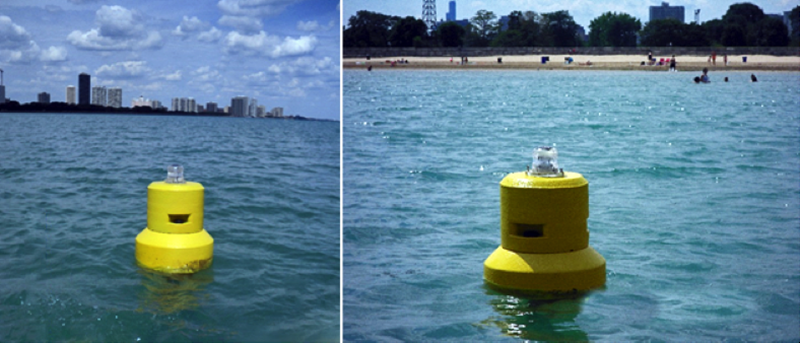Beach buoys deployed to detect beach contamination

Beachgoers may soon be able to know in a timely manner if the water is clean enough for swimming, thanks to some new technology developed by researchers from Michigan State University and the U.S. Geological Survey.
The technology comes in the form of buoys that are deployed in the water near a beach. By combining statistical models with real-time data that are gathered by sensors embedded in the buoys, they provide quick and dependable information on water quality.
"Current beach-management practices are slow and unreliable," said Phanikumar Mantha, an MSU professor of civil and environmental engineering and a member of the research team. "A water sample needs to be gathered, then taken to a lab for analysis. That can be anywhere from 24 to 48 hours.
"If you go to the beach today and swim, then you find out tomorrow you shouldn't have gone, that's not very helpful."
Here is how this new technology works: The sensors in the buoys gather the information, everything from temperature to how clear the water is. Using a cellular modem on board the buoy, the data are uploaded to a land-based server.
From there, it uses web-based technology - an RSS feed - to get the information to the people who need to know, for example, a parks official who then makes the decision whether or not to close the beach and web pages that provide the same information to the public.
Data from the sensors are used to automatically run executable programs specific to E. coli, which Mantha said is an "indicator bacteria."
The technology gives authorities the information they need to make the correct decision.
"That can have a real effect on local economies," Mantha said. "If you close a beach unnecessarily, it's hurting the local businesses."
Work on this early warning system has been ongoing for more than a decade and is being used on a number of Lake Michigan beaches in Chicago.
"Our ultimate goal is to protect the public from getting exposed to contaminated water," Mantha said. "This problem can be particularly hard on children and seniors, who tend to be more susceptible to its dangers."
Details of this research are published by the MSU - USGS team in the journals Environmental Science and Technology and the Journal of Environmental Management.
More information: Ammar Safaie et al. Comparative Evaluation of Statistical and Mechanistic Models ofat Beaches in Southern Lake Michigan, Environmental Science & Technology (2016). DOI: 10.1021/acs.est.5b05378
Dawn A. Shively et al, Prototypic automated continuous recreational water quality monitoring of nine Chicago beaches, Journal of Environmental Management (2016). DOI: 10.1016/j.jenvman.2015.10.011
Journal information: Environmental Science and Technology , Journal of Environmental Management , Environmental Science & Technology
Provided by Michigan State University





















